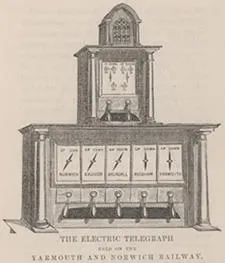
His famous dispute with William Fothergill Cooke over the paternity of the electric telegraph might obscure this, but Cooke was not a scientist. The collection can also shed light on the social and personal connections which sustained science in 19th century Britain. This applies particularly to Wheatstone’s work in telegraphy, electromagnetism and electric resistance where his connections to the physicists Lord Kelvin (1824-1907) and George Carey Foster (1835-1919) are apparent.
There are some important inscriptions of prominent Victorians in the collection who were not scientists. These include the sanitary reformer Edwin Chadwick (1800-90), the Radical MP Joseph Hume (1777-1855) and the civil servant Sir Rowland Hill (1795-1879), who introduced the ‘penny post.’ All three were adherents of the Utilitarian movement, to which Wheatstone may have been drawn because of its emphasis on applying scientific and engineering expertise to social problems. Engineers feature to some extent in the collection: pamphlets bear the inscriptions of the pioneer of steel manufacture Sir Charles William Siemens (1828-83) and of the pioneer of agricultural drainage pipes, Josiah Parkes (1793-1871).
The professionalism of science
As an indication of the growing ‘professionalisation’ of science in Wheatstone’s era, most of the scientists with whom Wheatstone was acquainted held academic positions, although there are important exceptions. Pamphlets bear the inscription of the wealthy amateur scientist William Henry Fox Talbot (1800-77), who was one of the inventors of photography, of the astronomer and banker Sir John William Lubbock (1803- 65), and of William Sturgeon (1783-1850), who earned a precarious living by feeding the Victorians’ voracious appetite for popular scientific lectures. A pamphlet bears the inscription of William Whewell (1794-1866), who coined the term ‘scientist’ in the 1830s, and who founded the discipline of the history and philosophy of science.
Of the scientists, most came from the British Isles, although there are a number of important European and American names. These include Alexander Dallas Bache (1806-67), the pioneer of American coastal surveys, and of large-scale scientific enterprise in the United States; the Belgian statistician and astronomer Adolphe Quetelet (1796-1874), who applied the application of statistics to social science; the Belgian physicist Joseph Antoine Ferdinand Plateau (1801-83); and the German physicist Moritz Hermann von Jacobi (1801-74), whose experiments with electromagnets and telegraphy paralleled Wheatstone’s own.
King's connections
There are a number of inscriptions of figures who held academic posts at King’s College London, which flowed from Wheatstone’s long association with that institution. These include the physicist James Clerk Maxwell (1830-79); the physicist and King’s College chaplain Henry Moseley (1801-72); the Anglican ecclesiastic Alfred Barry (1826-1910), who became principal of King’s in 1868; the chemists John Frederic Daniell (1790-1845) and William Allen Miller (1817-70); and the physician and public health reformer William Augustus Guy (1810-85). Most of these figures had connections with Wheatstone’s research interests.
Among those scientists who were responsible for the mathematical turn in 19th century physics and whose inscriptions are in the collection are Lord Kelvin, James Prescott Joule (1818-89) and Sir George Gabriel Stokes (1819-1903). ‘Pure’ mathematicians, such as Augustus de Morgan (1806-71) and James Booth (1806-78), also feature.
The collection includes items which were inscribed by astronomers who, via new research in terrestrial magnetism, applied the findings of their discipline to meteorology, and who often devised new magnetic, meteorological and navigational instruments. These figures include John Welsh (1824-59), Humphrey Lloyd (1800- 81), Balfour Stewart (1828-87), Thomas Romney Robinson (1793-1882) and Charles Piazzi Smyth (1819-1900).
Using Library Search
Records from all collections are available through King's Library Search.
Being signed in to Library Search gives the best functionality for searching and the homepage gives advice on how to narrow down your searches by using scopes and by filtering searches you have made. For full instructions please see both the Library Search homepage and also our 'Catalogues' webpage, available by scrolling down to the menu on the Special Collections homepage.
Using scopes
You can limit your search to Foyle Special Collections Library items by using scopes.
If you select the ‘Library Resources’ scope, only the print and ebooks, audiovisual material and journals held by the campus libraries and Foyle Special Collections Library will be retrieved in your searches
Using filters
For finding material related to specific collections or former owners, use the ‘Library Resources’ scope in the drop down menu and then filter by ‘Former owner’ in the Advanced search criteria to display records from a specific collection.
You can also use the Location drop down menu on the left hand side of the screen to identify items from specific named special collections.
Please do contact us for further advice on identifying material which will assist you with your studies.
King's College London Archives
The College Archives of King's College London hold a significant amount of material relating to Sir Charles Wheatstone including notes and apparatus and have published a detailed catalogue to Wheatstone's papers and instruments.
Further Reading
Brian Bowers. Sir Charles Wheatstone FRS, 1802-1875. London: HMSO, 1975. [Maughan Library Science Books QC16.W5 B6]
Brian Bowers. Sir Charles Wheatstone FRS, 1802-1875. London: Institution of Electrical Engineers, 2001. [Maughan Library Science Books QC16.W5 BOW ]
"The electric telegraph: Sir C. Wheatstone's share in its invention". The scientific review, and Journal of the Inventors' Institute, Vol. III, No. 11, 2 November, 1868. [Wheatstone Collection TK5118.C7 COO]
Charles Gillispie (ed.) Dictionary of scientific biography. New York: Scribner, 1973. Maughan Library Science Ref. Books Q141 D56
Geoffrey Hubbard. Cooke and Wheatstone and the invention of the electric telegraph. London: Routledge, [1965]. [Early Science Collection TK5118.C7 H87]
P. Thompson. "Wheatstone, Sir Charles (1802–1875)", rev. Brian Bowers. Oxford Dictionary of National Biography, Oxford University Press, 2004 [http://www.oxforddnb.com/view/article/29184] [Accessed 19 Sept 2006]
N.J. Wade. 'Charles Wheatstone'. Perception, 2002, Vol. 31.